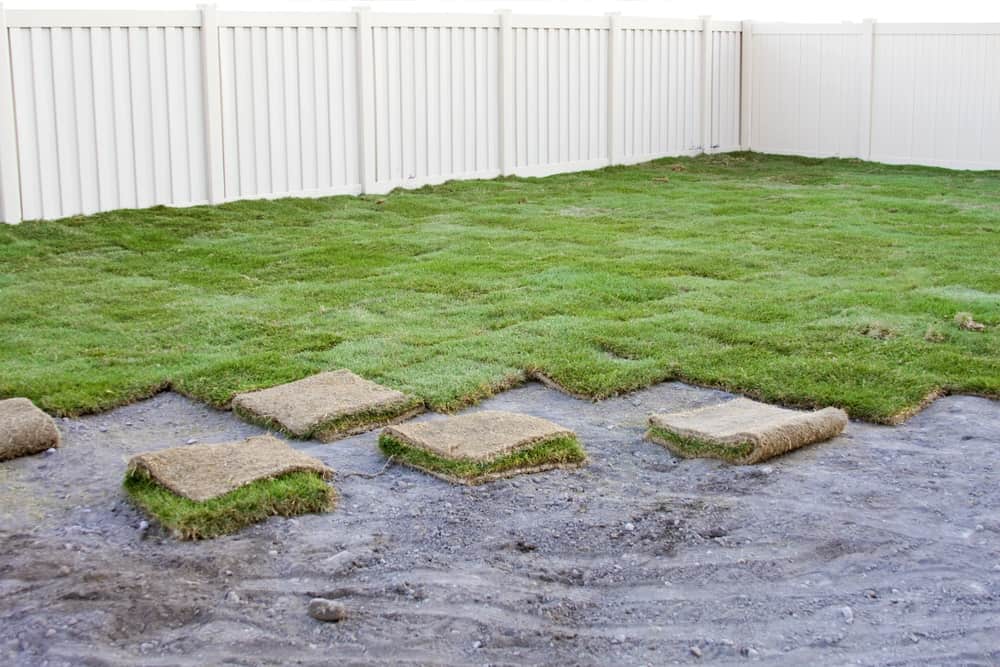In the sun-drenched landscapes of Tampa and its neighboring counties, the lush greenery of well-maintained sod has become synonymous with curb appeal for homes and businesses alike.
The strategic installation of sod not only enhances aesthetics but also offers a myriad of benefits for property owners.
As the demand for sod installation rises, particularly in the thriving real estate market, more homeowners, landscapers, and property managers are recognizing the transformative impact of fresh sod on both residential and commercial buildings.
However, the flourishing of new sod comes with its set of challenges, especially in the face of water restrictions that have become a norm in Florida.
The recent Modified Phase I Water Shortage Orders in Hillsborough, Pasco, and Pinellas counties, effective since December 1, 2023, have significantly impacted lawn watering, limiting it to once a week.
This restriction encompasses all forms of irrigation, posing a potential threat to the health of new sods.
But fear not, for we bring you professional, easy, and practical tips to ensure your new sod not only survives but thrives within the confines of these stringent regulations.
From the optimal choice of sod species tailored to your specific needs to meticulous ongoing maintenance in compliance with evolving water restrictions, we’ve got you covered.
Ignoring these regulations could have consequences, and that’s why consulting with sod installation experts and relying on reputable suppliers, such as Council Growers Sod in Tampa, is crucial for ensuring your investment remains green, healthy, and compliant.
Join us as we discuss and reveal insider tips on new sod care — helping you maintain your property’s allure while adhering to Florida’s water conservation initiatives.
What Is Water Restriction, And What Does It Mean For Your New Sods in Tampa?
Water restrictions are temporary regulations put in place by local authorities to conserve water during periods of shortage.
In Tampa Bay, restrictions were implemented due to the driest rainy season in over two decades. These restrictions typically limit how often and when you can water your lawn and landscape.
What does the Modified Phase I Water Shortage Order mean?
This means that the allowable days for lawn watering have been reduced to once per week, affecting all forms of landscape irrigation, including the nurturing of new sod.
Moreover, specific rules, such as designated watering hours and percentage coverage requirements for irrigation zones, must be followed diligently.
For new sod owners in Tampa, these water restrictions pose a challenge to maintaining the vibrancy and health of their lawns.
Properly caring for recently installed sod requires a more frequent and consistent watering schedule than what these restrictions permit.
Consequently, it becomes crucial to adopt professional, practical strategies to ensure your new sod not only survives but thrives within these limitations.
What Do Restrictions Mean for Your New Sod?
As we hinted earlier, new sod needs consistent moisture to establish strong roots and prevent drying out. This can feel daunting when water restrictions are in place.
But fear not!
With some smart strategies, you can keep your new sod healthy and green even amidst limited watering.
Watering Hacks for New Sod During Restrictions
Watering your new sod during water restrictions in Tampa requires a strategic approach to ensure its health and vitality.
Here is a list of effective watering hacks to keep your sod thriving within the confines of the regulations:
- Deep Soaking
Focus on deep watering rather than shallow sprinkling. Water less frequently but more profoundly, encouraging the roots to grow deeper into the soil. Aim for 1 inch of water per week, applying it slowly to allow for thorough soaking.
- Early Morning or Evening Watering
Choose cooler parts of the day to water your sod—either early in the morning or evening. This minimizes water loss through evaporation during the heat of the day, ensuring more moisture reaches the roots.
- Mow High
Maintain a taller grass height (around 3 inches) to provide shade to the soil. This reduces evaporation and helps retain moisture, promoting healthier sod.
- Use a Rain Gauge
Keep track of rainfall with a rain gauge. This information helps you gauge when additional watering is necessary, allowing you to supplement as needed.
- Fix Leaks
Regularly inspect your irrigation system for leaks or drips that may wastewater. Fixing these issues ensures efficient water usage.
Additional Tips:
- Hand-water specific areas prone to drying out faster.
- Opt for drought-tolerant grass varieties when choosing sod.
- Explore alternative water sources like rainwater barrels or reclaimed water if available.
Remember:
Being water-conscious doesn’t mean compromising the health of your new sod. By incorporating these intelligent watering practices and staying informed about local regulations, you can maintain a vibrant lawn even during water restrictions.
Consult with Council Growers Sod (sod installer and lawn care professional) for personalized advice, ensuring your sod remains resilient and attractive in the Tampa Bay climate.
With thoughtful planning and effort, you can enjoy a flourishing lawn while responsibly managing water resources in Tampa Bay.
PS: A thriving lawn not only enhances your property’s aesthetics but also contributes to a cooler home, improved air quality, and erosion prevention.
How To Choose The Best Sod Variety For Your Lawn During Water Restriction
Selecting the right sod variety is a critical step in ensuring the success and resilience of your lawn, especially when facing water restrictions.
Before delving into the top grass picks and types of grass for Florida water restrictions, here are tips you should consider to make an informed decision.
Armed with these tips, you are set to enjoy a lush and vibrant lawn without the stress of costly maintenance:
- Climate Compatibility
Choose a sod variety that thrives in the specific climate of Tampa and its surrounding areas.
Opt for grass types that are well-adapted to the region’s warm and humid conditions, ensuring they can endure both the occasional droughts and heavy rainfall.
- Drought Tolerance
Prioritize sod varieties known for their drought tolerance. These grasses have the ability to withstand periods of water scarcity, making them ideal for regions with water restrictions.
- Watering Requirements
Different sod varieties have varying water needs. Some are more water-efficient, requiring less irrigation to maintain their health.
Understanding the watering requirements of your chosen sod type can significantly impact your ability to comply with water restrictions.
- Soil Compatibility
Consider the soil conditions of your property. Certain sod varieties thrive in specific soil types. Choosing a sod that is compatible with your soil ensures better establishment and long-term health.
- Sun or Shade Preferences
Evaluate the sunlight exposure in your lawn. Some sod varieties prefer full sun, while others can survive in shaded areas. Matching the sod’s preferences with your lawn’s sunlight conditions contributes to its overall vitality.
- Wear Tolerance
If your lawn experiences heavy foot traffic, select a sod variety with high wear tolerance. This ensures that your lawn remains resilient and attractive, even under frequent use.
- Disease Resistance
Check for sod varieties with natural resistance to common lawn diseases. Disease-resistant sods require less maintenance and are more likely to withstand challenges during water restrictions.
By carefully considering these factors when choosing your sod variety, you set the foundation for a low-maintenance and resilient lawn.
This proactive approach not only aligns with your local water regulations but also ensures that your investment thrives in the unique conditions of Tampa and its neighboring areas.
Now, armed with a well-suited sod variety, let’s explore effective watering tips to help your lawn flourish despite water restrictions.
Sod for Water Conservation: Best Sod Varieties for Residential and Commercial Properties in Florida
Choosing the right sod variety can make all the difference in maintaining a beautiful, healthy lawn while being water-wise.
Let’s explore the top picks for both residential and commercial properties:
- Bahia Grass (Paspalum notatum)
Drought Tolerance: Bahia grass is renowned for its exceptional drought tolerance, making it an ideal choice for regions with water restrictions.
Low Maintenance: This grass variety requires minimal irrigation and thrives in full sunlight.
Wear Tolerance: Bahia grass handles foot traffic well, making it suitable for both residential and commercial landscapes.
- Zoysia Grass (Zoysia spp.)
Drought Resistance: Zoysia grass varieties, such as Empire Zoysia, exhibit good drought resistance, allowing them to withstand water restrictions.
Adaptability: Zoysia grass adapts well to various soil types and is suitable for both sun and partial shade conditions.
Lush Appearance: Known for its lush, green appearance, Zoysia provides an aesthetically pleasing lawn even with limited water.
- Bermuda Grass (Cynodon dactylon)
Drought Tolerant: Bermuda grass is well-known for its ability to survive drought conditions, making it a popular choice in water-restricted areas.
Sun-Loving: Thriving in full sunlight, Bermuda grass is perfect for lawns that receive ample sunlight exposure.
Quick Recovery: Bermuda grass recovers quickly from stress, making it resilient during challenging weather conditions.
- St. Augustine Grass (Stenotaphrum secundatum)
Adaptability: St. Augustine grass, especially the Floratam variety, is adaptable to a range of soil types.
Shade Tolerance: Known for its shade tolerance, St. Augustine grass is suitable for lawns with varying sunlight conditions.
Disease Resistance: Resistant to certain diseases, St. Augustine grass requires less maintenance during water restrictions.
PS: Before making a final decision, it is always best to consult with local sod experts and consider the specific conditions of your property.
What’s the Best Time of Day to Water the Grass in Florida?
In response to the Water Shortage Order, unincorporated Hillsborough County has implemented modified watering days, hours, and measures to ensure responsible water use.
Compliance with these regulations is essential to avoid fines imposed by Hillsborough County Code Enforcement. It’s important to note that there are no changes to the exemptions for new sod watering days.
Here’s a breakdown of the key components of the Water Shortage Order:
Watering Days
Know your designated watering day based on the last digit of your address:
- Monday: Addresses ending in 0 or 1
- Tuesday: Addresses ending in 2 or 3
- Wednesday: Addresses ending in 4 or 5
- Thursday: Addresses ending in 6 or 7
- Friday: Addresses ending in 8 or 9, common areas, locations with no addresses, and mixed addresses (e.g., office complexes, shopping centers)
Watering Hours
All watering activities must be completed either before 8 AM or after 6 PM on your designated watering day.
Exemptions
- Reclaimed Water: The use of reclaimed water for lawn and landscape activities is exempt from the Water Shortage Order.
- Alternative Irrigation Water Sources: There are no exemptions for alternative irrigation water sources, including the Alternative Irrigation Water Source Registration.
Measures to Follow:
- Prevent Runoff: Avoid overwatering and address issues with broken or misdirected sprinkler heads to prevent water runoff.
- Recycle Water: Whenever possible, recycle water to contribute to conservation efforts.
- Voluntary Water Reduction: Property owners and managers are required to voluntarily reduce water use.
Be prepared for potential worsening conditions and more stringent water shortage actions if circumstances deteriorate.
- Stay Informed: All water users have a responsibility to stay informed about water use restrictions and any additional required actions applicable to their property.
Sod Survival 101: Expert Answers to Your Top Questions on Sod Care During Water Restrictions
- Can I even install new sod during water restrictions in Florida?
Installing new sod during water restrictions is feasible, but it requires careful planning.
Choose a drought-tolerant grass type, schedule installation on your designated watering day, and follow proper watering practices to ensure successful establishment within the regulatory framework.
- How often should I water my new sod during water restrictions?
Watering frequency is crucial. Aim for deep soaking, providing 1 inch of water per week, to promote robust root growth.
Find the balance between optimal hydration and water conservation by adhering to the designated watering days and hours outlined in the water restrictions.
- What are the best drought-tolerant grass types for new sod in Florida?
Opt for grass varieties like Bahia, Zoysia, Bermuda, St. Augustine, or Seashore Paspalum.
These are well-suited for Florida’s dry conditions, ensuring your new sod thrives even with limited watering.
- How can I deep soak my new sod efficiently while following water restrictions?
Efficiently deep soak your new sod by watering slowly before 8 AM or after 6 PM on your designated day. This helps prevent runoff and encourages roots to grow deeper, making the most of the limited watering time.
- Will my new sod die if I don’t water it enough during restrictions?
While new sod is resilient, insufficient watering during restrictions can lead to stress and potential damage. Monitor signs of drought stress and adjust your watering practices accordingly to maintain the health of your sod.
- Can I use alternative water sources like rainwater or reclaimed water for my new sod?
Explore legal options for alternative water sources like rainwater or reclaimed water, as they may be exempt from water restrictions. Check local regulations to ensure compliance while supplementing your new sod’s hydration.
- What happens if I get caught violating water restrictions with my new sod?
Violating water restrictions can result in fines. Awareness of potential consequences emphasizes the importance of responsible water use and compliance with the established regulations for your new sod.
- Are there any special fertilizers or additives that help new sod survive drought conditions?
Consider using drought-resistant fertilizers and soil conditioners to enhance your new sod’s resilience. Consult with our experts to find products specifically designed to support sod health during dry periods.
- Should I mow my new sod differently during water restrictions?
Maintain proper mowing practices, keeping your grass around 3 inches tall to provide shade and reduce evaporation. Adjust your mowing schedule to align with water restrictions while ensuring your new sod stays healthy.
- How can I tell if my new sod is getting enough water during restrictions?
Watch for signs of drought stress, such as wilting or discoloration. Adjust your watering practices accordingly, ensuring your new sod receives adequate hydration within the constraints of water restrictions.
- Do I need to aerate my new sod during water restrictions?
Aerating your new sod can be beneficial for water absorption. If necessary, schedule aeration on your designated watering day and follow local guidelines to promote a healthy lawn.
- What should I do if my new sod starts showing signs of drought stress?
If drought stress appears, adjust your watering schedule, and consider using targeted hand-watering. Addressing the issue promptly helps your new sod recover and thrive despite water restrictions.
- Will water restrictions damage my new sod permanently?
While water restrictions pose challenges, proper care and adherence to guidelines can mitigate potential damage. Timely and appropriate watering practices can help your new sod adapt and remain healthy.
- How can I design my new lawn to be more drought-resistant?
Opt for drought-resistant plants, install efficient irrigation systems, and incorporate mulch to retain moisture. Thoughtful design choices contribute to a more resilient lawn, even during water restrictions.
- Are there any financial incentives for installing drought-tolerant landscaping in Florida?
Check for local programs or incentives promoting water-efficient landscaping.
Some regions offer rebates or financial support for incorporating drought-tolerant elements into your lawn, promoting sustainable practices.
Ready To Transform Your Lawn And Make Your Outdoor Space Amazing?
Reach out to our friendly experts at Council Growers Sod.
We’ve got a fantastic guide to help you care for your new sod and can give you personalized advice on picking the best natural turf grass sods in Tampa.
Plus, we’re here for professional sod installation and supply services.
Contact us today, and let’s get started on your beautiful lawn journey!


